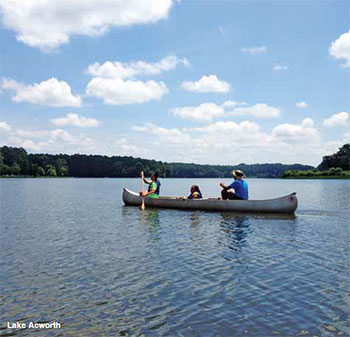It’s no secret that Georgia summers are some of the hottest around. Rising temperatures have Cobb County residents searching for a way to let loose and cool down in the dog days of summer, and the county is home to plenty of activities for the whole family.
Six Flags Over Georgia’s Hurricane Harbor brings a whole new element of fun and relaxation to the theme park. The park is home to four water slides, a state-of-the-art wave pool and an exciting play area for younger children. Six Flags White Water, the largest water park in the southeast, gives families a more varied water park adventure, while Lake Acworth and the Chattahoochee River National Recreation Area provide a reprieve from the heat the old-fashioned way. With temperatures routinely encroaching triple-digits, there’s no better time to discover the various water adventures Cobb has to offer.
Six Flags Over Georgia
Hurricane Harbor at Six Flags Over Georgia marked the largest expansion in the park’s history. Cobb families can escape to their own mini-getaway in this tropically landscaped park that features a 38,000-square-foot wave pool, the multi-slide Bonzai Pipelines, a children’s play area and the Tsunami Surge, the world’s first hybrid zero-gravity slide. The park also includes shopping and dining experiences, as well as extensive lounging and shade areas.
“We’re happy to expand our offering to guests of the park as part of our commitment to contribute to Cobb County,” says Dale Kaetzel, park president, “but the pure joy and relaxation on people’s faces is why we built Hurricane Harbor.”
The water park spans seven acres across the area formerly occupied by the Southern Star Amphitheatre in Austell and is included with the admission to Six Flags Over Georgia.

Six Flags White Water
Marietta-based Six Flags White Water also continues to be a favorite stop for Cobb families looking to beat the heat. The park features more than 20 rides for children, families and thrill-seekers, including relaxing lazy rivers, wave pools and multiple slides. There’s something for everyone, and a day at the park can be as exciting or laid-back as you want it to be.
 Lake Acworth
Lake Acworth
The City of Acworth, aptly nicknamed “The Lake City,” is home to Lake Acworth and three family-friendly parks perfect for escaping the sultry weather. Entry into these parks is free for all Acworth residents, and non-residents only pay a small parking fee for the day.
The lake area’s Dallas Landing Park has a pavilion, volleyball court, horseshoe pit, multiple grills and picnic tables and public beach access for a full day of fun and is open from 8 am to 9 pm. Proctor Landing Park, also located in that area, is open from 8 am to 9 pm during the season, and visitors will have access to the same amenities found at Dallas Landing.
Lake Acworth’s Cauble Park allows families to take advantage of multiple fishing points, a public beach and two playgrounds for children to enjoy, as well as a boating ramp for those who want to venture a little farther from the beach. It is open from 6 am to 10 pm, and non-residents pay a small parking fee.
 Chattahoochee River Parks
Chattahoochee River Parks
The Chattahoochee River National Recreation Area consists of 17 distinct park areas along 48 miles of river, and four of these parks can be found in Cobb. These areas are perfect for those looking to cool off in the river and enjoy the beautiful scenery the Chattahoochee has to offer.
The Johnson Ferry North park, located at the corner of Johnson Ferry Road and Columns Drive in Marietta, and Paces Mill park area are popular for visitors to rent rafts, tubes, kayaks, canoes and other water equipment. Johnson Ferry North is also a popular put-in spot for those with their own boating equipment, and Paces Mill is the last chance to leave the river at an official boat ramp before leaving the Chattahoochee River National Recreation Area.
Cochran Shoals, a three-mile trail located between Columns Drive and Interstate North Parkway, is a great location for runners, walkers and cyclists to enjoy the peaceful views of the Chattahoochee. The Akers Mill Road stretch contains Sandy Point and Diving Rock Beach, two very popular locations for people paddling down the river. “Although the river seems serene at this point, it is 15 feet deep and the water temperature is rarely above 60 degrees,” cautions Rudy Evenson, chief of visitor services at the Chattahoochee River National Recreation Area. As with all outdoor water activities, visitors to this location should exercise caution and use common sense to avoid injuries.
To learn more about these areas and/or additional features or costs visit:






















 Lake Acworth
Lake Acworth Chattahoochee River Parks
Chattahoochee River Parks